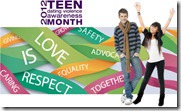 February is National Teen Dating Violence month in the United States. According to the Center for Disease Control, 10% of all teens between 7th grade and 12th grade experience teen dating violence. Teens who are abused are are higher risk for substance abuse, developing depression, developing eating disorders and attempting suicide.
February is National Teen Dating Violence month in the United States. According to the Center for Disease Control, 10% of all teens between 7th grade and 12th grade experience teen dating violence. Teens who are abused are are higher risk for substance abuse, developing depression, developing eating disorders and attempting suicide.
South Asian teens are at added risk for experiencing teen dating violence because many of them feel they have to hide their relationships from their parents. Without parental supervision, South Asian teens in violent relationships are less likely to know how to protect themselves and get out of the relationship. This increases their sense of isolation and significantly increases the risk of developing depression as well.
Dating violence, which is abuse, can be physical, emotional/verbal or sexual and can occur in either gender. The primary motivation of the abuse is to control the other person. Here are the most common warning signs that it may be an abusive relationship:
Jealousy – Teens may mistake this to be an act of caring but if their partner is insecure about the jealousy is a form of control.
Controlling behavior – This can include controlling how the teen dresses, what the teen eats or who the teen spends time with.
Insults or put downs – Name calling, put downs or any type of berating either publically or privately is a red flag.
Threatening to hurt oneself – In an effort to gain sympathy and to control behavior, a partner may threaten to hurt him/herself in order for the teen to behave in the way that he/she wants.
Blackmail – If a partner threatens to expose the teen or share secret information if the teen does not comply with their terms, it is a clear sign that the relationship is abusive.
Pressure – This can include pressure to drink, smoke, go to certain places, eat specific things or sexual pressure are all signs of an abusive relationship.
Unfortunately, teens who are in an abusive relationship during adolescence are more likely to be in an abusive relationship during adulthood. Parents, teachers and coaches should all be aware of the signs that their child might be in an abusive relationship.
Unexplained injuries – If your teen suddenly has bruises, cuts or marks it could be an indication of an unhealthy relationship.
Sudden change in appearance – This may be due to the controlling behavior of the partner or in an effort to hide visible marks on the body.
Increased isolation from friends and family. Similar to adult abusive relationships, isolation is one of the hallmark characteristics of an adolescent violent relationship. This is often a result of a highly controlling partner.
Mood changes. Signs of depression or anxiety can include increased aggressive behavior, increased moodiness, apathy, sadness or crying more frequently.
Justifying partner’s behavior especially temper. Your teen may quickly jump to the partner’s defense even if the partner’s behavior was completely out of line.
Walking on eggshells. Afraid to make his/her partner angry, your teen may feel afraid of upsetting their partner and may tread more carefully than you have seen your teen behave.
Changes in academic performance. Some teens are able to maintain perfect grades while being in an abusive relationship while others experience a drop in academic performance.
Teens and all adults who are around teens regularly should be aware of the red flags associated with teen dating violence. The sooner the teen leaves the abusive relationship, the better off he/she will be in the long run emotionally and physically. South Asian parents may have trouble accepting that their teen has been dating behind their back. However, being aware of the realities of teen dating violence can help your teen recover from a potentially dangerous situation.
Empowered, educated teens will make healthier decisions about their relationships during adolescence and adulthood. Spread the knowledge this month!
